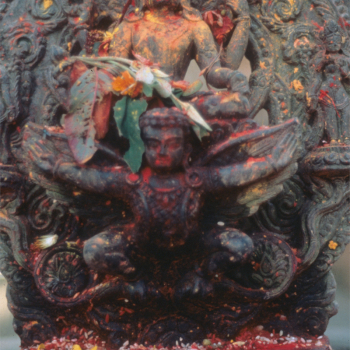The Silk Routes were of great importance in the passage of not only goods and crafts but also of religions and ideologies throughout Central Asia, the Near East and Europe. Buddhism spread from India into northern Asia, Mongolia, and China, whilst Christianity and Islam emerged and were disseminated by trade, pilgrims, and military conquest. The literary, architectural and artistic effects of this can be traced today in the cultures of civilizations along the Silk Routes.
The customs surrounding the burial of the dead are a unique insight into the values and beliefs of the living, and for this reason, the archaeological excavation of graves and burial sites is the principal means by which we can form an understanding of the religions of the Xinjiang region. There are a large number of ancient grave sites in this region of China, among which the largest are the Xiangbaobao graves of Tashkurgan, the Lou-lan graves at Lop Nor, and the pebble and chamber grave sites at Alagou.
The cross-fertilization of religions and cultures across Central Asia and the Indo-Persian world was fundamental to the development of Asian societies between the early sixteenth and the mid-nineteenth centuries. Movement of people and goods along the trading routes of this macro-region resulted in the transfer of beliefs and religious practices too, and ultimately, changes to these religions themselves.
Religions moved along the Silk Roads with the passage of goods, spreading beliefs and traditions throughout Asia and beyond. Religions varied from tribe to tribe among the nomads of the steppes, although there were many features in common. In the countries of southern and western Asia, Manichaeism, Zoroastrianism, Hinduism and Christianity were widely followed until the advent of Islam, in the early seventh century, resulting in the conquest of the region by Islamic armies and the resulting dissemination of the religion.
The slate cliffs of Kazakhstan bear evidence of an ancient Sun God cult, represented in anthropomorphic form, and worshipped two millennia before the start of the Common Era. There are no written documents to supply details of this cult or of the worship it entailed, but many engravings, especially at the cultic site of Tamgaly, show a humanised ‘Sun’, sometimes accompanied by a zoomorphic figure.
Marco Polo’s expedition to the east between 1271 and 1295 was written up on his return in his book The Travels of Marco Polo. It was looked upon as being a collection of fables as much as facts, but did much to shape European perceptions of Asia. His accounts of Buddhism in Sri Lanka are particularly interesting for religious and cultural history, both in what he found to be note-worthy, and in what he omitted. He was clearly fascinated by Buddhism and the life of the Buddha, and described certain religious rites in detail.
Dunhuang, in the Gansu province of China, was an important Buddhist center between the years 500 and 1,000 AD, and hosted a large number of monasteries. Pilgrims from China, India and Tibet met here and in the nearby Mogao Caves, where there is a large extant body of Buddhist art and written sources, forming our most detailed source of information about the Buddhist communities of China, and their interaction with co-religionists from other countries, in this era.
Before the era of large-scale tourism, trade was one of the principal means by which people of different religions and cultures came into contact with each other. Although Buddhism is not traditionally a religion that actively seeks to ‘convert’ others, it nonetheless spread across South East Asia and became a widely followed religion in many countries in the Middle Ages, due largely to the voyages of Buddhist traders across Central Asia.






